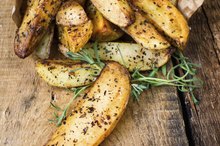Balanced Oxidizer Diet
The balanced oxidizer is a term that refers to your body’s ability to metabolize sugars and carbohydrates that you put into your body into energy. There are three identified oxidizer types; those who metabolize carbohydrates quickly but burn the energy they ingest almost immediately; those who metabolize carbohydrates slowly that therefore are able to store energy easily in the form of fat; and those who are balanced in their ability to burn and store carbohydrates. If you are a balanced oxidizer, you should eat a certain way, but be sure to talk to your doctor before starting any diet plan to ensure that you’re getting all the nutrients you need daily.
Choosing Your Oxidation Type
The concept of fast, slow and balanced oxidation comes from well-known trainer and fitness expert Jilian Michaels, who notes that you can determine your type by answering a questionnaire 2. She recommends that balanced oxidizers eat a diet that is 40 percent carbohydrates, 30 percent protein and 30 percent fat. This diet helps you burn the calories ingested in a timely manner without giving them time to be stored as body fat.
Diet
Somersizing Diet Plan Tips
Learn More
One of the concepts introduced by Michaels in this new way of thinking about health and fitness is that you can customize the kinds of carbohydrates, fats and proteins based on your body’s specific metabolism. She notes that people who are identified as balanced oxidizers often do well on diets that balance these food types, such as the Zone Diet.
Purines and Proteins
For people who are identified balanced oxidizers, Michaels recommends eating ratios of the foods mentioned earlier, but including high-fat and high-purine proteins as well as low-fat and low-purine foods because their bodies metabolize these two types of proteins differently than fast or slow oxidizers. Some of these low-purine protein foods include catfish and other seafood. High-purine foods include red meat and the dark meat from poultry.
Carbohydrates
How Is Starch Stored in Humans?
Learn More
If you’re a balanced oxidizer you should stay away from carbohydrates that are full of easy-to-metabolize sugars like high glycemic index foods and processed grains and sugars. Stick with brown rice, whole wheat breads and vegetables that contain a low starch levels. You should eat plenty of dark green, leafy vegetables and include plenty of nigh-nutrient grains and complex carbohydrates like those found in potatoes.
Fats and Oils
The remaining 30 percent of your balanced oxidizer diet should be in the form of good fats that are found in foods like seeds and nuts. Try to minimize the kinds of fats that are found in low-quality meats and heavily processed foods. Forgo the high-fat cooking oil in favor of extra virgin olive oil and coconut oil.
Related Articles
References
Resources
Writer Bio
Keith Strange spent more than a decade as a staff writer for newspapers in the southeastern United States, winning numerous awards for his work. He has a B.S. in wellness/sports medicine from Averett University and completed graduate work in exercise physiology. Strange is a former competitive martial artist and holds a third-degree black belt in tae kwon do.









